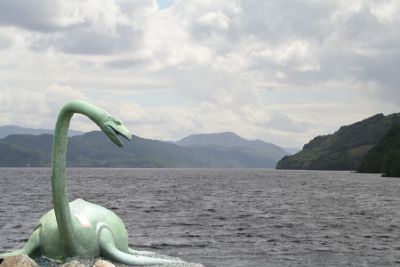The Loch Ness Monster - behind the myth
DOES THE LOCH NESS
MONSTER REALLY EXIST ? . No one knows for certain. But
one thing is certain: there cannot be just ONE monster. lf there is one
monster, there must be a whole family of them....at least twenty. No
creature could have survived alone for over 7000 years! ..
 Photomontage
- the monster at the visitor centre with Loch Ness in the background
Photomontage
- the monster at the visitor centre with Loch Ness in the backgroundA VERY OLD STORY
The first written story of the monster is in a text from the year 565 AD by a Celtic biographer: this writer describes how a man was attacked by a monster while he was swimming in the river Ness. Perhaps the legend already existed in those days: it has certainly existed for many centuries in Scottish folklore.However, the story of the monster was not very well-known in England for one simple reason: Loch Ness is a very long way from the rest of Britain. Until the age of the railway, very few people ever went to the Highlands of Scotland....except soldiers or officials from the cities of the Scottish Lowlands. No-one else had any reason to go there: the North of Scotland was wild and desolate, wet and generally cold, and inhabited more by sheep than by people.
The myth became big news in 1930; three men, out in a boat on the lake, said that they had seen a monster. Immediately, several other people said that they had seen one too. In 1933, a man took the first "photo" of the monster, from a distance of about 100 metres. The photo was not clear, but Kodak said that the photo was real. The most famous photo of all was taken in 1934 by a London surgeon; it seems to show a long neck and a small head sticking up out of the water. "Nessie" - if the photo is real - looks something like a dinosaur.
A lot of other photos have been taken since then, but none of them have been clear. Obviously, if there is a monster, it is a shy one! It doesn't often come to the surface, and it never does so near the shore on a sunny afternoon in summer!
If it had done so, lots of people would have taken photos of it, and there would be no more mystery. Until now it has tried to avoid publicity.... if it exists!
In 1987, some people used sonar equipment to try to discover Nessie.... but they found.... nothing. So no-one has proved that the Loch Ness monster exists; but no-one can prove that it does not exist. It's a great story.

biographer: writer - legend : myth, old story - folklore : popular traditional stories - desolate: empty - inhabited: lived in - surgeon: a specialist doctor - shy : timid.
Return to Linguapress site index
► More legends and mysteries: See the Looking for the Yeti / Robin Hood
Student Worksheet
The Loch Ness Monster
Interactive: Fill in the missing prepositions in this extract from the article
Replace the missing prepositions in this extract from the text:You will need EIGHT of the following NINE prepositions: at, by, for, from, in, of, on, out, up,
However, the story the monster was
not very
well-known England one simple reason:
Loch Ness is a very long way the
rest Britain.
Until the age the railway,
very few people ever went the
Highlands Scotland....except soldiers
or
officials the
cities the
Scottish Lowlands. No-one else had any reason
go there: the North Scotland was wild and
desolate, wet
and generally cold, and inhabited more sheep
than
people.
The myth became big news 1930; three men, out a boat the lake, said that they had seen a monster. Immediately, several other people said that they had seen one too. 1933, a man took the first "photo" the monster, a distance about 100 metres. The photo was not clear, but Kodak said that the photo was real. The most famous photo all was taken 1934 a London surgeon; it seems show a long neck and a small head sticking the water. "Nessie" - if the photo is real - looks something like a dinosaur.
The myth became big news 1930; three men, out a boat the lake, said that they had seen a monster. Immediately, several other people said that they had seen one too. 1933, a man took the first "photo" the monster, a distance about 100 metres. The photo was not clear, but Kodak said that the photo was real. The most famous photo all was taken 1934 a London surgeon; it seems show a long neck and a small head sticking the water. "Nessie" - if the photo is real - looks something like a dinosaur.
This
teaching
resource
is ©
copyright Linguapress - renewed 2020.
Text orignally published in Horizon,
the low-intermediate
level
English
newsmagazine.
Republication on other websites or in print is not authorised
| Linguapress; home | Découvrez l'Angleterre (en français) | Discover Britain |



